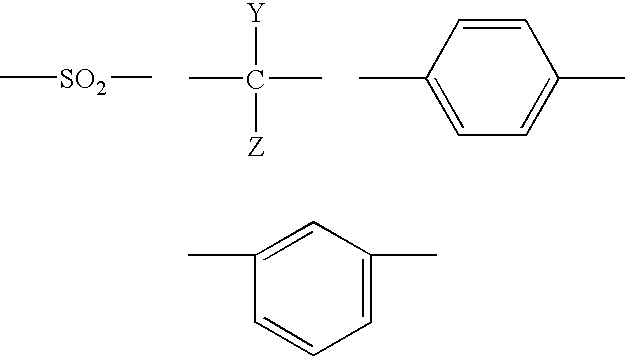Heat sensitive recording material
a recording layer and heat-sensitive technology, applied in thermography, printing, duplication/marking methods, etc., can solve the problems of failure to achieve sufficient color gradation reproduction, failure to achieve sufficient sensitivity and image density, and heat-sensitive recording materials described, so as to improve color optical density, prevent a deposit from adhering, and increase the adhesion between the heat-sensitive recording layer and the support.
- Summary
- Abstract
- Description
- Claims
- Application Information
AI Technical Summary
Benefits of technology
Problems solved by technology
Method used
Image
Examples
example 1
Preparation of Electron-Donating Dye Precursor Dispersion
[0153]20 parts of 3-N,N-dibutylamino-6-methyl-7-anilinofluoran were mixed with 80 parts of an aqueous solution of polyvinyl alcohol (trade name: PVA-105 manufactured by Kuraray Co., Ltd.) at a concentration of 5%. After mixing, the mixture was milled with a sand mill to prepare an electron-donating dye precursor dispersion having a volume-average particle diameter of 0.6 μm. The volume average-particle diameter was measured by a laser diffraction particle size distribution measuring instrument (LA500 manufactured by Horiba, Ltd.).
Preparation of Sensitizer Dispersion
[0154]20 parts of 1-benzyloxynaphthalene were mixed with 70 parts of an aqueous solution of polyvinyl alcohol (PVA-105) at a concentration of 5%. After mixing, the mixture was milled with a sand mill to prepare a sensitizer dispersion having a volume-average particle diameter of 0.6 μm. The volume average-particle diameter was measured by a laser diffraction particl...
example 2
Preparation of Protective Layer Coating Solution
[0158]A protective layer coating solution was obtained by mixing 50 parts of polyvinyl alcohol (PVA-117 manufactured by Kuraray Co., Ltd.) at a concentration of 5%, 0.8 parts of Hydrorin Z-7 (manufactured by Chukyo Yushi Co., Ltd) at a concentration of 31%, 0.8 parts of Hydrorin D337 (manufactured by Chukyo Yushi Co., Ltd) at a concentration of 31%, and 30 parts of water to give a protective layer coating solution.
Preparation of Coating Solution for Heat Sensitive Recording Layer
[0159]A coating solution (2) for a heat sensitive recording layer (2) was obtained in the same manner as in Example 1 except that 2 parts of 28% hollow particle dispersion SX8782 (D) (average particle diameter of 1.1 μm, degree of hollowness=82%, manufactured by JSR Co., Ltd.) were used as a hollow particle dispersion in place of SX866 (B).
Preparation of Heat Sensitive Recording Material
[0160]The coating solution (2) for a heat sensitive recording layer (2) was...
example 3
Preparation of Developer Dispersion
[0161]20 parts of 4-[4-(1-methylethoxy)phenylsulfonyl]phenol (trade name: D-8, manufactured by Nippon Soda Co., Ltd.) were mixed with 70 parts of an aqueous solution of polyvinyl alcohol (PVA-105) at a concentration of 5%, and then milled with a sand mill to prepare a developer dispersion (B) having an average particle diameter of 0.6 μm.
Preparation of Coating Solution for Heat Sensitive Recording Layer
[0162]A coating solution (3) for a heat sensitive recording layer was obtained in the same manner as in Example 1 except that the developer dispersion (B) obtained above was used in place of the developer dispersion (A), and 2 parts of 26% hollow particle dispersion “Hollow Plastic Pigment HPP-055” (average particle diameter of 1.1 μm, degree of hollowness=75%, manufactured by CMKOR Co., Ltd.) were used as a hollow particle dispersion in place of SX866 (B), in preparation of the coating solution (1) for a heat sensitive recording layer of Example 1.
P...
PUM
| Property | Measurement | Unit |
|---|---|---|
| volume-average particle diameter | aaaaa | aaaaa |
| particle diameter | aaaaa | aaaaa |
| volume-average particle diameter | aaaaa | aaaaa |
Abstract
Description
Claims
Application Information
 Login to View More
Login to View More - R&D
- Intellectual Property
- Life Sciences
- Materials
- Tech Scout
- Unparalleled Data Quality
- Higher Quality Content
- 60% Fewer Hallucinations
Browse by: Latest US Patents, China's latest patents, Technical Efficacy Thesaurus, Application Domain, Technology Topic, Popular Technical Reports.
© 2025 PatSnap. All rights reserved.Legal|Privacy policy|Modern Slavery Act Transparency Statement|Sitemap|About US| Contact US: help@patsnap.com



